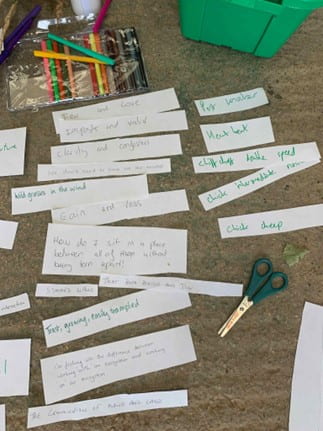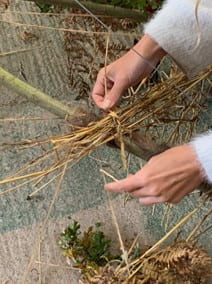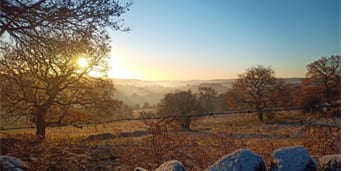
I generally assume a shared story of division between wild and human, between divine and mundane, between self and other and in meeting one another we pick up at the point where our shared story diverges from the sense of ourselves as a person, as an individual. We start with our name and age, our profession. We might acknowledge ourselves as a part of a larger, but still nuclear, family. We form the container of self in the mind of another. As conversations progress we often divulge how we met our partner or how we started out in our profession, how we defined and became who we are. An individual, expecting and striving for stasis.
It is fairly uncommon to meet someone in their entirety – the entirety of the family, the community and the more than human world of which their life is an expression and a part. To meet the complexity of a whole though a single human face.
But that is what we are doing at every meeting; unacknowledged, lulled by the constant chatter of neoliberalism and dampened by money, we are meeting faces and assuming their individualism.
I am from this place – this landscape, time and community, a face pulled from complexity, although so far this place is not from me. I have done very little to create or influence this landscape or community, restrained behind walls of my belief in my own implicit negativity – an inheritance of environmentalism and scientific reductionism, to leave no trace, that the damage of my species lies encoded within my DNA.
For me the process of engaging with this project was about exploring what lay beyond the wall of self, beyond the bounds of the individual and the assumption of implicit damage being the basis of my humanity. To step beyond that wall is to step out of being an individual and to step into nothing that the culture in which I was raised can understand. It is to step into change, into process, into becoming.
In coming to this place I have wanted to step beyond that wall, to start to know this landscape and life and become a small part of its larger being. To be in becoming amidst it.
To me that is what relearning connection is, to landscape and to community, and it is a process that Brigstow has sheltered from the eroding forces of capitalism whilst in its embryonic form.
Brigstow has provided an umbrella, a membrane both porous and protective, that has allowed people from many complexities of life and landscape to meet in this place and talk about what it could be to be human beyond the walls of self.
The conversations have been wide and free, have rambled from the deep past to the multiplicity of futures. Have dreamed and have also mused upon allowing themselves to be dreamed by community, by landscape, by complexity and by emergence.
Language has been the primary tool that we have used throughout this process and careful sculpting into story, narrative, poetry and song has been the craft of this exploration. Language has both constrained and facilitated our exploration beyond the wall, it has highlighted barriers and also broken through them. Language, and words, intrinsically separate us from the ‘named other’ that becomes enclosed within the definitions of the word expelled beyond the definitions of the ‘self’ but words are also the first contact that we can make to bridge the chasms that they have created between them. The same tool expressed through different crafts to form bridges rather than deepen barriers.

But words, with their borders and definitions, can only bring us so far. Bridges are only of benefit between defined places and across unfavorable land and words help to create those chasms in the first place.
Maybe there is a better, more embodied and intuitive form of connection beyond language, but to reach it we need more time. Time to build trust in one another, time to understand each others words and worlds. Time to hear the stories that we all carry and to listen to the lands story that we are all now spun within. Time to become familiar after an initial meeting.
My story has been one of trying to find a place, a whole, of which I can be a beneficial part. Work that I can do that is not metered out in hours for a wage but that is gifted as life force to a greater whole. To a Gaian Earth.
I first imagined this work as an ecologist might, as a niche for people within the ecosystems of the wild. That is what led me into landscapes. But, in finding myself here I have found that I am not an ecologist after all, I am a permeable clustering of life within a living system upon the fringes of which words and stories dance.
Brigstow has allowed the exploration of these words and hopefully in the coming year our ecological niche and the new songs and stories of place within it can merge. Craft surpassing language, the next phase of greeting community and landscape in this place.
Crafts that unite us as people in common endeavor and as participants in living systems. Crafts of food gathering, sharing and sowing, crafts of tending the wild and of allowing ourselves to be tended by it. Crafts of shared song, of gleaned wisdom from different places and pasts. Crafts that bind us within the rest of life and facilitate the co-creation of a new world.

The words for craft and art were one until recently, all human creations were purposeful and all creation was beautiful. Creation was co-creation, a shared expression drawn by human hands from landscapes in an endless cyclical endeavor, the fusion and merger of humanity and the whole. Words could be seen as what emerges as one person’s sensing edges of self meet and spark with another’s, the inherent dynamism and richness of peripheries captured in freshly spun thoughts and feelings. Craft could be viewed as an analogous meeting of humanity and the wild.


